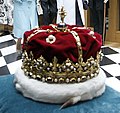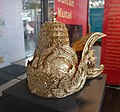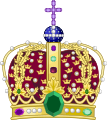Crown


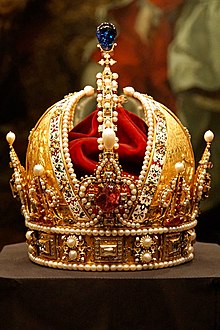


A crown is a traditional form of head adornment, or hat, worn by monarchs as a symbol of their power and dignity. A crown is often, by extension, a symbol of the monarch's government or items endorsed by it. The word itself is used, particularly in Commonwealth countries, as an abstract name for the monarchy itself, as distinct from the individual who inhabits it (that is, The Crown). A specific type of crown (or coronet for lower ranks of peerage) is employed in heraldry under strict rules. Indeed, some monarchies never had a physical crown, just a heraldic representation, as in the constitutional kingdom of Belgium.
Variations
- Costume headgear imitating a monarch's crown is also called a crown hat. Such costume crowns may be worn by actors portraying a monarch, people at costume parties, or ritual "monarchs" such as the king of a Carnival krewe, or the person who found the trinket in a king cake.
- The nuptial crown, sometimes called a coronal, worn by a bride, and sometimes the bridegroom, at her wedding is found in many European cultures since ancient times. In the present day, it is most common in mother of pearl. They are placed on the heads of the newlyweds and are held together by a ribbon of white silk. They are then kept by the couple as a reminder of their special day. In Slavic weddings, the crowns are usually made of ornate metal, designed to resemble an imperial crown, and are held above the newlyweds' heads by their best men. A parish usually owns one set to use for all the couples that are married there since these are much more expensive than Greek-style crowns. This was common in Catholic countries in the past.
- Crowns are also often used as symbols of religious status or veneration, by divinities (or their representation such as a statue) or by their representatives (e.g., the Black Crown of the Karmapa Lama) sometimes used a model for wider use by devotees.
- According to the New Testament, a crown of thorns was placed on the head of Jesus before his crucifixion; it has become a common symbol of martyrdom.
- According to ceremonially crownedduring May.
- The Crown of Immortality is also common in historical symbolism.
- The heraldic symbol of Three Crowns, referring to the three evangelical Magi (wise men), traditionally called kings, is believed thus to have become the symbol of the Swedish kingdom, but it also fits the historical (personal, dynastic) Kalmar Union (1397–1520) between the three kingdoms of Denmark, Sweden, and Norway.
- In Indianized kingdomsthat was influenced by Hindu-Buddhist concept of kingship in Southeast Asia, such as in Java and Bali in Indonesia, Cambodia, Burma and Thailand.
- In East Asia, there were crowns such as the Chinese mianguan and Japanese benkan worn by emperors.
- Dancers of certain traditional mongkut) on their head. These are inspired in the crowns worn by deities and by kings.
- In pre-Colonial
- The Fatimid Caliphates.[3]
Terminology
Three distinct categories of crowns exist in those monarchies that use crowns or state regalia.
- Coronation
- Worn by monarchs when being crowned.
- State
- Worn by monarchs on other state occasions.
- Consort crowns
- Worn by a consort, signifying rank granted as a constitutional courtesy protocol.
Crowns or similar headgear, as worn by nobility and other high-ranking people below the ruler, is in English often called a coronet; however, in many languages, this distinction is not made and the same word is used for both types of headgear (e.g., French couronne, German Krone, Dutch kroon). In some of these languages the term "rank crown" (rangkroon, etc.) refers to the way these crowns may be ranked according to hierarchical status. In
History
Crowns have been discovered in pre-historic times from
Numerous crowns of various forms were used in antiquity, such as the Hedjet, Deshret, Pschent (double crown) and Khepresh of Pharaonic Egypt. The Pharaohs of Egypt also wore the diadem, which was associated with solar cults, an association which was not completely lost, as it was later revived under the Roman Emperor Augustus.[5] By the time of the Pharaoh Amenophis III (r.1390–1352c) wearing a diadem clearly became a symbol of royalty. The wreaths and crowns of classical antiquity were sometimes made from natural materials such as laurel, myrtle, olive, or wild celery.[6]
The corona radiata, the "
In the Christian tradition of European cultures, where ecclesiastical sanction authenticates monarchic power when a new monarch ascends the throne, the crown is placed on the new monarch's head by a religious official in a coronation ceremony. Some, though not all, early
Today, only the
The
Special headgear to designate rulers dates back to pre-history, and is found in many separate civilizations around the globe. Commonly, rare and precious materials are incorporated into the crown, but that is only essential for the notion of crown jewels.
, often decorated crowns; so too in Polynesia (e.g., Hawaii).Coronation ceremonies are often combined with other rituals, such as enthronement (the throne is as much a symbol of monarchy as the crown) and anointing (again, a religious sanction, the only defining act in the Biblical tradition of Israel).
In other cultures, no crown is used in the equivalent of coronation, but the head may still be otherwise symbolically adorned; for example, with a royal
Gallery
-
Crown of Darius the Great, c. 500 BC.
-
The ancient Greek Kritonios Crown, funerary or marriage material, 370–360 BCE, from a grave in Armento, Basilicata (State Collections of Antiquities, Munich).
-
Tillya Tepe Crown (Afghanistan, 1st century AD)
-
The Essen Crown, the world's oldest lily crown (10th or 11th century), cathedral treasury, Essen Minster, Essen
-
The Papal tiara, worn by the popes to symbolize their authority within the Catholic Church, was last used in 1963 (St. Peter's Basilica, Vatican City).
-
St Edward's Crown (1661)
-
Crown of the Crowned Virgin of the Kings (Corona de la Virgen de los Reyes Coronada), 1904, Seville Cathedral
-
Crown of the Andes, ca. 1660-1770, made for a larger than life-size statue of the Virgin Mary in the Cathedral of Popayán, Colombia. Now is at the Metropolitan Museum of Art[8]
-
Crown ofIsabella of Castile in the Royal Chapel of Granada
-
Crown of the Virgin of the Tabernacle ofCathedral of Toledo, c. 15th century, Spain
-
Imperial crown of Maximilian I of Mexico (1864-1867) as funerary insignia, located in the Imperial Furniture Collection in Vienna.
-
Imperial Crown of Pedro II of Brazil (1841)
-
The Holy Crown of Hungary, also called the Crown of Saint Stephen, of the Kingdom of Hungary (Byzantine work, Constantinople (Istanbul), 11th century), Hungarian Parliament Building, Budapest
-
sequins, diamonds and rubies.
-
Württemberg State Museum, Stuttgart(1806)
-
Crown of Stephen Bocskai (Turkish goldwork, c. 1605, Imperial Treasury, Vienna)
-
ThePalatine Crown, also called the Bohemian Crown, of Princess Blanche of England, c. 1370–80, Munich Residenz
-
Crown of Empress Cunigunde c. 1060–1070, Munich Residenz
-
Gothic lily crown of Empress Cunigunde, 14th century (Munich Residenz)
-
Reliquary Crown of Henry II, Munich Residenz c. 1270–1300
-
Crown of Augustus III of Poland c. 1733
-
Crown on the bust of John the Baptist, c. 1370, St. Johann-Baptist church, Aachen
-
Crown of Queen Therese of Bavaria (c. 1830), Munich Residenz
-
Crown of Margaret of York c. 1461, Aachen Cathedral
-
Empress Crown (Iran-Pahlavi dynasty)
-
Replica of the destroyed Crown of Bolesław I the Brave of Poland.
-
Medieval Crown of Bulgaria kept in the National history museum of Bulgaria
-
Russian tsar's crown(14th century)
-
Royal Crown of Sweden (1561)
-
Replica of the crown designed for the Finnish monarch, who was never chosen. A contemporary crown was never crafted, but the replica was made from original drawings in the 1980s.[9]
-
Reproduction of Imperial Crown ofNapoleon III of France.
-
TheMing Dynasty) (1368–1644)
-
Karađorđević Crown(Serbia)
-
Makuta Binokasih, the crown of Sunda Kingdom, 14th century West Java, Indonesia
-
The crown of King Christian IV of Denmark (16th century), currently located in Rosenborg Castle, Copenhagen.
-
Crown of Louis XV
-
Crown of King George XII of Georgia
-
The crown ofKutai Kartanegara Sultanate, 19th century East Kalimantan, Indonesia
-
The Great Crown of Victory (Thailand)
-
Imperial Crowns of Head of the States of Kingdom of Nepal (19th century). Preserved
-
Kingdom of IranPahlavi Golden Crown
-
Crown of the King of Norway
-
Heraldic crown of the Russian Empire.
-
Heraldic version of the crown of Tonga.
-
ThePalatine tiara of Pope Pius IX(19th Century)
-
Crown of Flowers, by William-Adolphe Bouguereau, 1884.
-
Ströhl's Heraldischer Atlas, 1899
-
TheEmperor George V at his Delhi Durbar(1911).
-
Tiara of Pope Benedict XVI (21st Century)
-
Yoruba Oba's crownof Onijagbo Obasoro Alowolodu; late 19th century
Numismatics
Because one or more crowns, alone or as part of a more elaborate design, often appear on coins, several monetary denominations came to be known as 'a crown' or the equivalent word in the local language, such as krone. This persists in the case of the national currencies of the Scandinavian countries and the Czech Republic. The generic term "crown sized" is frequently used for any coin roughly the size of an American silver dollar (ie., approximately 26.5mm diameter).
See also
- Benkan
- Circlet
- Coronet
- Crown jewels
- Diadem
- Fengguan
- Helmet
- Holy Crown of Hungary (Crown of St. Stephen)
- Hoop crown
- Heraldic crowns
- Imperial Crown
- Korymbos (headgear)
- Laurel wreath
- Makuṭa
- Mianguan
- Mitre
- Goffa
- Nemes
- Oba's crown
- Papal tiara
- Polos
- Presidential sash
- Pschent
- Tiara
- Chada and mongkut
- List of Royal Crowns
- Ukpe-okhue
- War bonnet
- Hat
- Tefillin
References
- ^ Itsios, Alex. "Gold of Ancestors - Ayala Museum". www.ayalamuseum.org. Archived from the original on 2017-06-25. Retrieved 2017-07-01.
- ^ "12 Surprising Facts You Didn't Know About Ancient Philippines". 4 July 2018. Archived from the original on 9 July 2017. Retrieved 1 July 2017.
- ISBN 90-04-10422-4. Archived(PDF) from the original on 2022-03-25. Retrieved 13 June 2022.
- ^ "Stone Pages Archaeo News: 4,000-year-old copper crown unearthed in India". Archived from the original on 2021-09-28. Retrieved 2020-12-16.
- ISBN 1-86064-609-3.
- ^ "Winners of Panhellenic Games Received Victory Wreaths". ThoughtCo. Archived from the original on 2023-03-10. Retrieved 2023-03-10.
- ^ in Alexander the false prophet Archived 2016-11-26 at the Wayback Machine)
- ^ "Crown of the Virgin of the Immaculate Conception, known as the Crown of the Andes". Metropolitan Museum of Art website. Archived from the original on 2023-05-18. Retrieved 2023-06-04.
- ^ "Gemstone Gallery". 2018-05-29. Archived from the original on 2018-05-29. Retrieved 2022-10-04.
External links
- Fallow, Thomas Macall (1911). . In Chisholm, Hugh (ed.). Encyclopædia Britannica. Vol. 7 (11th ed.). Cambridge University Press. pp. 515–518.



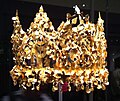







![Crown of the Andes, ca. 1660-1770, made for a larger than life-size statue of the Virgin Mary in the Cathedral of Popayán, Colombia. Now is at the Metropolitan Museum of Art[8]](http://upload.wikimedia.org/wikipedia/commons/thumb/d/d9/Crown_of_the_Virgin_of_the_Immaculate_Conception%2C_known_as_the_Crown_of_the_Andes_MET_DP365520.jpg/103px-Crown_of_the_Virgin_of_the_Immaculate_Conception%2C_known_as_the_Crown_of_the_Andes_MET_DP365520.jpg)









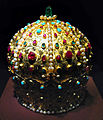
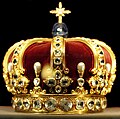
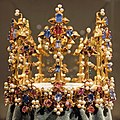


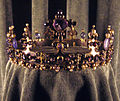












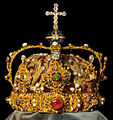
![Replica of the crown designed for the Finnish monarch, who was never chosen. A contemporary crown was never crafted, but the replica was made from original drawings in the 1980s.[9]](http://upload.wikimedia.org/wikipedia/commons/thumb/d/dd/King_of_Finland%27s_crown2.jpg/112px-King_of_Finland%27s_crown2.jpg)


